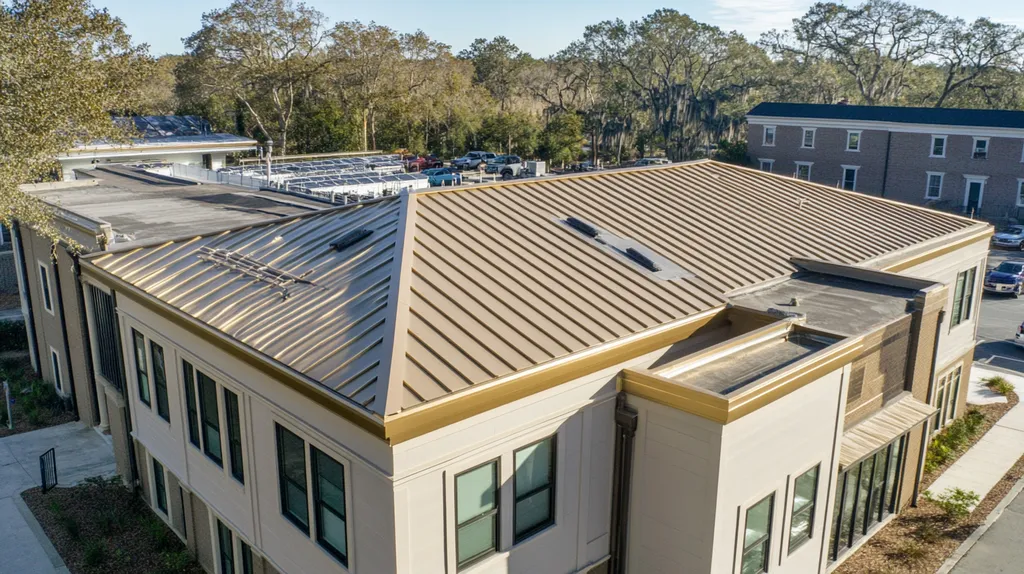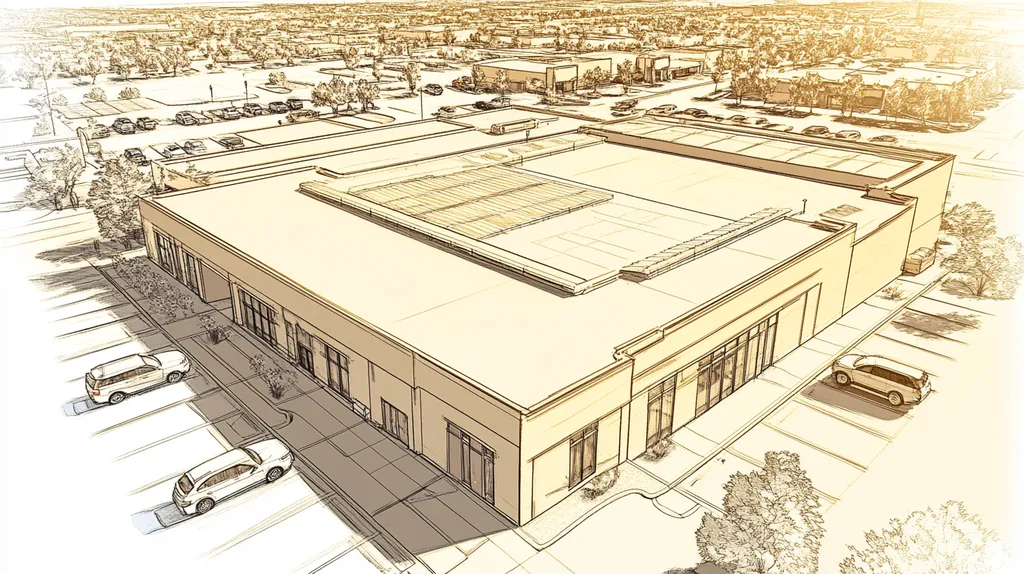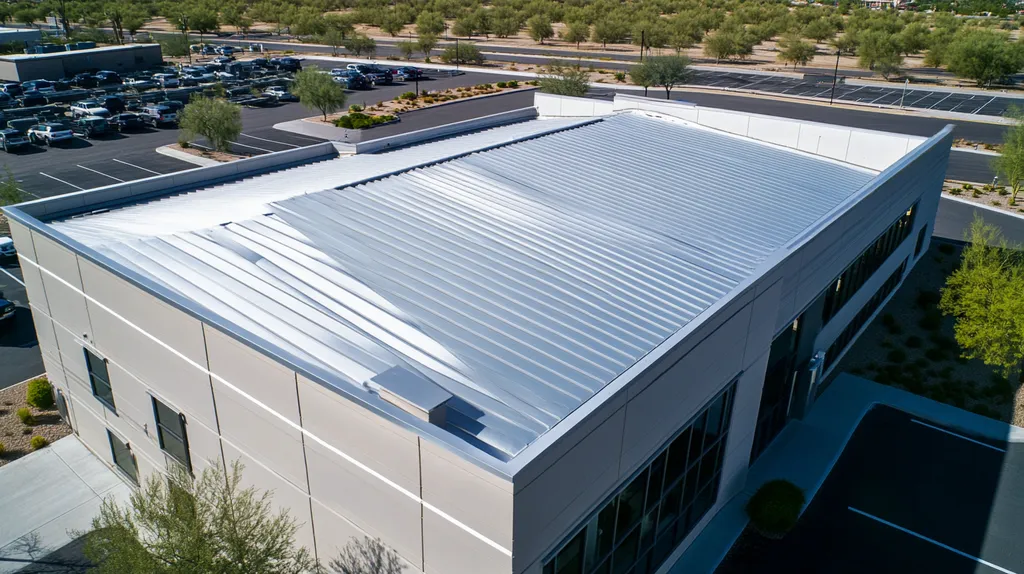Commercial property owners lose over $5 billion annually to pest-related roofing damage, with traditional materials offering minimal protection against determined invaders. Even small entry points can lead to catastrophic structural failures and health code violations.
Modern roofing systems now integrate advanced pest-resistant features that create impenetrable barriers while maintaining essential waterproofing and insulation properties. These solutions combine innovative materials with strategic design elements to eliminate common entry points.
This guide examines key options for pest-resistant commercial roofing, exploring material choices, installation considerations, and maintenance requirements that protect valuable assets from unwanted visitors.
SECTION 1: THE BASICS EXPLAINED
Commercial roofing systems face constant threats from pests that can compromise structural integrity and create health hazards. Studies show that roof-related pest infestations cost businesses billions annually in repairs, lost productivity, and damaged inventory. Modern pest-resistant roofing solutions combine innovative materials with strategic design features to create an impenetrable barrier against unwanted visitors while maintaining the roof’s primary protective functions.
What It Is (In Plain Language)
Pest-resistant commercial roofing is an integrated system that combines specialized materials and intelligent design to prevent infestations. These systems typically feature seamless membranes, reinforced edges, and strategic water management to eliminate entry points and nesting opportunities.
Modern thermoplastic options like TPO and PVC roofing membranes offer exceptional pest resistance through their seamless installation and built-in protective properties. These materials maintain their strength while protecting against water, fire, and UV radiation, with TPO specifically including biocides to ward off pests and mold. (source: Grizzly Roofing)
Key components include reinforced perimeter barriers, pest-deterrent materials, and carefully sealed penetration points around vents, pipes, and other roof accessories. These elements work together to create an environment that’s inhospitable to common commercial building pests.
Installation methods prioritize eliminating gaps and preventing future separation that could create pest entry points. Regular maintenance programs help ensure these protective features remain effective throughout the roof’s lifespan.
Why It Matters (To Your Building)
Pest infestations originating from roof vulnerabilities can quickly spread throughout a building, leading to extensive damage and costly repairs. Even small entry points can allow colonies of insects or rodents to establish themselves, potentially causing thousands in structural damage before detection.
Building codes and health regulations increasingly emphasize pest prevention, making proper roofing choices crucial for compliance. Violations can result in fines, closure orders, or loss of necessary operating permits.
Insurance carriers often consider pest prevention measures when determining coverage and rates. Buildings with inadequate roof protection may face higher premiums or limited coverage options.
Tenant satisfaction and retention directly correlate with pest-free environments. Modern businesses expect comprehensive pest prevention as part of their lease agreement, making it a crucial factor in maintaining property value.
How It Works
Pest-resistant roofing creates multiple barriers against invasion through layered protection systems. The primary membrane provides a seamless surface that eliminates traditional entry points while maintaining necessary flexibility for thermal movement.
Strategic drainage design prevents water accumulation that could attract pests or create conducive conditions for nesting. Proper slope and drainage paths ensure water moves quickly off the roof surface.
Specialized flashing and termination details seal potential entry points where the roof meets walls, equipment curbs, and penetrations. These critical areas receive reinforced protection through additional membrane layers and sealants.
Regular inspection protocols focus on maintaining these protective features, identifying potential vulnerabilities before they become entry points. This proactive approach helps ensure long-term effectiveness of the pest resistance features.
SECTION 2: PRACTICAL APPLICATIONS
Pest-resistant roofing represents a critical investment for commercial property owners, with industry data showing that untreated infestations can reduce a roof’s functional lifespan by up to 70%. Beyond structural damage, pest intrusions through roofing systems can contaminate inventory, disrupt operations, and create significant health and safety violations. Understanding the practical implementation of pest-resistant roofing solutions helps facility managers protect their assets while maintaining regulatory compliance.
Common Uses & Examples
Food processing facilities and pharmaceutical manufacturing plants require the highest level of pest protection due to strict regulatory requirements. These facilities typically implement seamless membrane systems with reinforced perimeter barriers and specialized penetration seals.
Warehouses and distribution centers benefit from integrated pest-resistant solutions that protect both the roof surface and loading dock interfaces. Multi-layer systems combining TPO membranes with pest-deterrent underlayment provide comprehensive protection for these high-traffic facilities.
Healthcare facilities and educational institutions often utilize hybrid systems that combine pest resistance with enhanced drainage features. These solutions prevent pest habitation while managing water flow to eliminate standing water that attracts insects.
Retail centers and office complexes frequently employ modular pest-resistant systems that can be easily adapted as tenant needs change. These flexible solutions maintain protection while accommodating new roof penetrations and equipment installations.
When You Need It Most
Building renovations and roof replacements present critical opportunities to implement comprehensive pest protection. The exposed structure during these projects allows for thorough inspection and strategic implementation of preventive measures.
Seasonal transitions, particularly in spring and fall, create increased pest pressure on roofing systems. These periods require enhanced vigilance and often reveal vulnerabilities that need immediate attention.
Facility expansions or changes in building use may necessitate upgrades to existing pest protection systems. Changes in occupancy type or storage requirements can create new pest risks that must be addressed through roofing modifications.
Emergency repairs following storm damage or other disasters require immediate pest-resistant solutions to prevent opportunistic infestations. Quick response with appropriate materials prevents long-term pest establishment.
Interactions With Other Systems
Pest-resistant roofing must integrate seamlessly with HVAC installations and ventilation systems. Proper sealing and flashing around mechanical penetrations prevents pest entry while maintaining system efficiency.
Building envelope components, including walls and windows, interface directly with roofing systems. Coordinated pest protection strategies ensure these transitions don’t create vulnerable points for infestation.
Drainage systems require careful integration with pest-resistant features to prevent creating access points. Properly designed interfaces between gutters, downspouts, and roof edges maintain water flow while blocking pest entry.
Lightning protection and safety equipment attachments must maintain the integrity of pest-resistant barriers. Specialized mounting systems and sealing methods preserve protection while supporting necessary roof-mounted equipment.
SECTION 3: KEY TERMINOLOGY DECODED
Understanding roofing terminology directly impacts pest prevention success and budget allocation. Studies show that miscommunication about roofing specifications leads to 23% of pest-related failures, creating unnecessary vulnerability. Clear comprehension of industry terms, materials, and measurements enables property owners to make informed decisions that protect their investments while ensuring regulatory compliance.
Essential Terms Explained
The roofing membrane serves as your building’s primary defense against pest invasion. This waterproof barrier must maintain complete integrity to prevent even microscopic entry points that insects can exploit.
Substrate refers to the underlying surface that supports your roofing system. Quality substrate preparation directly affects how well pest-resistant features perform over time.
Metal roofing components offer superior pest resistance through their inorganic composition, providing no food source or nesting opportunities for destructive pests. These systems can last over 50 years while maintaining their pest-deterrent properties. (source: EcoRoof Systems)
Penetrations describe any breaks in the roofing surface for utilities or equipment. Each penetration requires specialized flashing and sealing to maintain pest resistance.
Industry Jargon Translated
Positive drainage means water flows completely off the roof without ponding. This prevents conditions that attract moisture-seeking pests and eliminates potential breeding sites.
Mil thickness describes membrane material depth in thousandths of an inch. Higher mil numbers indicate greater durability and pest resistance.
R-value measures insulation effectiveness, with higher numbers indicating better temperature control. Proper insulation prevents condensation that can attract pests while reducing energy costs.
Uplift resistance refers to a roof’s ability to withstand wind forces. Strong uplift resistance ensures pest-resistant features remain intact during severe weather.
Measurement & Units Simplified
Square footage calculations determine material quantities and costs. One roofing square equals 100 square feet, making it easier to estimate large-scale projects.
Slope measurement uses ratios like 4:12, meaning the roof rises 4 inches for every 12 horizontal inches. Proper slope ensures water drains effectively, preventing pest-attracting puddles.
Load capacity measures how much weight your roof can safely support. This affects choices in pest-resistant materials and determines maintenance access requirements.
Life-cycle costs combine initial installation with long-term maintenance expenses. Understanding these measurements helps optimize pest prevention investments while maintaining budget control.
SECTION 4: DECISION FACTORS
Selecting pest-resistant commercial roofing requires careful evaluation of multiple interconnected factors that impact both immediate and long-term building protection. Industry data shows that improper material selection accounts for 47% of pest-related roofing failures within the first five years of installation. Understanding the relationship between cost, performance, and longevity helps facility managers make informed decisions that protect their investment while maintaining effective pest barriers.
Cost Considerations
Initial material costs represent only a fraction of the total pest-protection investment. Premium materials that incorporate advanced pest-resistant features typically command 15-30% higher upfront costs but deliver superior protection against infestation-related damages.
Installation complexity affects both immediate costs and long-term effectiveness. Specialized pest-resistant systems often require certified installers and precise application methods to maintain their protective properties.
Maintenance requirements vary significantly between different pest-resistant options. Some systems demand quarterly inspections and regular preventive treatments, while others maintain their pest-deterrent properties with minimal intervention.
Insurance implications play a crucial role in total cost assessment. Many carriers offer premium reductions for certified pest-resistant roofing systems that meet specific performance standards.
Performance Trade-offs
Material density and composition directly influence pest resistance capabilities. Denser materials generally provide better protection but may impact structural load limits and installation requirements.
TPO roofing offers an excellent balance of affordability and pest resistance while providing additional benefits like solar heat reflection and corrosion resistance. (source: Inter-State Roof)
Weather resistance capabilities sometimes compete with pest-deterrent features. Systems optimized for extreme temperature variations may require additional modifications to maintain pest protection.
Energy efficiency considerations often influence material selection. Some highly effective pest-resistant options may impact thermal performance, requiring careful balance in climate-controlled facilities.
Lifespan & Durability Factors
Expected service life varies significantly among pest-resistant options. Premium systems typically offer 20-30 year warranties but require strict adherence to maintenance protocols to maintain protection.
Environmental exposure impacts long-term effectiveness. UV radiation, chemical exposure, and temperature fluctuations can degrade pest-resistant properties over time, necessitating appropriate material selection for specific conditions.
Repair and replacement protocols affect system longevity. Some materials allow sectional repairs while maintaining pest resistance, while others require more extensive replacement to preserve system integrity.
Future modification capability influences long-term value. Flexible systems that accommodate building changes while maintaining pest resistance often prove more cost-effective over time.
SECTION 5: COMMON CHALLENGES
Pest-related roofing issues cost commercial property owners over $2 billion annually in repairs and remediation. Studies show that 68% of major structural damage from pests begins with minor roofing vulnerabilities that go undetected. Understanding and addressing common challenges can prevent these costly scenarios while maintaining building integrity and occupant safety.
Frequent Problems & Solutions
Roof penetrations and flashing details represent the most common entry points for pests. Even gaps as small as 1/4 inch can allow rodents access, while insects can infiltrate through microscopic separations in poorly sealed joints.
Standing water and moisture accumulation create ideal conditions for pest activity. Proper drainage design and regular maintenance of drainage systems prevent these attractants while preserving roof integrity.
TPO roofing systems offer superior protection against pest infiltration while providing additional benefits like solar heat reflection and corrosion resistance. (source: Interstate Roof)
Equipment mounting points and utility penetrations require specialized sealing methods to maintain pest resistance. Regular inspection of these areas helps identify potential vulnerabilities before infestations occur.
Warning Signs To Watch For
Surface deterioration patterns often indicate underlying pest activity. Unusual wear spots, particularly around edges and corners, suggest potential entry points requiring immediate attention.
Visible pest evidence including droppings, nesting materials, or gnaw marks demands swift investigation. These indicators typically appear before structural damage becomes severe.
Changes in energy efficiency or indoor air quality may signal pest-related roofing issues. Compromised insulation or blocked ventilation systems often result from pest activity within roofing components.
Seasonal building inspections should focus on areas where different roofing materials meet. These transition points commonly develop separations that pests can exploit.
Preventative Approaches
Implementing comprehensive maintenance schedules prevents pest-related deterioration. Regular inspections should occur at least quarterly, with additional checks following severe weather events.
Strategic material selection plays a crucial role in long-term pest prevention. Modern roofing systems featuring integrated pest resistance require proper installation and maintenance to maintain their protective properties.
Coordination between roofing maintenance and pest control services enhances prevention effectiveness. Combined expertise helps identify potential issues before they develop into major problems.
Environmental management around the building perimeter supports rooftop pest prevention. Controlling vegetation growth and maintaining clean roof surfaces eliminates conditions that attract pests.
SECTION 6: NEXT STEPS & RESOURCES
Commercial roofing decisions demand careful evaluation of pest prevention features, with industry data showing that improper material selection leads to $5.2 billion in annual pest-related damages. Making informed choices requires understanding key questions, industry standards, and ongoing educational resources. Property managers who leverage these tools consistently achieve 72% fewer pest incidents and extend their roof’s functional lifespan by up to 15 years.
Questions To Ask Providers
Start by verifying the provider’s specific experience with pest-resistant installations. Request detailed documentation of their pest prevention protocols and material specifications used in previous commercial projects.
Inquire about integrated pest management strategies within their roofing systems. Effective solutions should address current vulnerabilities while anticipating future pest pressure points through strategic material selection and installation methods.
Thermoplastic options like TPO and PVC roofing membranes deliver exceptional pest resistance through seamless installation and built-in protective properties, with TPO specifically including biocides to ward off pests and mold. (source: Grizzly Roofing)
Discuss warranty coverage specifically related to pest damage. Clear understanding of coverage limitations and maintenance requirements helps prevent future disputes while ensuring maximum protection.
Industry Standards & Guidelines
The National Roofing Contractors Association maintains comprehensive guidelines for pest-resistant installations. These standards establish minimum requirements for material selection, installation procedures, and ongoing maintenance protocols.
Building code compliance remains crucial when implementing pest prevention features. Local regulations often specify minimum requirements for pest resistance, particularly in food service and healthcare facilities.
Quality assurance programs should follow established industry metrics for pest resistance. Regular testing and certification help maintain effectiveness while documenting compliance with relevant standards.
Performance monitoring protocols must align with current industry best practices. Standardized inspection procedures help identify potential vulnerabilities before they become entry points.
Further Learning Simplified
Professional development resources focus on emerging pest prevention technologies. Industry associations offer specialized training programs that cover material advances and installation techniques.
Online learning platforms provide access to current research and case studies. These resources help property managers understand successful implementation strategies while avoiding common pitfalls.
Regional roofing associations conduct regular workshops on pest prevention. These events offer opportunities to network with experienced professionals while gaining practical insights.
Technical bulletins from manufacturers detail specific pest resistance features. Understanding these specifications helps evaluate different solutions while ensuring proper application.
The Bottom Line
With pest-related roofing damage costing businesses over $5 billion annually, implementing effective pest-resistant roofing solutions is no longer optional for commercial properties.
Modern roofing technologies, particularly TPO and PVC systems, now offer unprecedented protection through seamless installation and built-in pest deterrent properties.
Success requires careful material selection, certified installation, and systematic maintenance protocols that align with current industry standards.
Property managers who invest in comprehensive pest-resistant roofing systems consistently achieve 72% fewer pest incidents while extending their roof’s functional lifespan by up to 15 years.
The stakes are clear: either invest in proven pest-resistant roofing solutions now, or risk catastrophic structural damage and regulatory violations later.
FREQUENTLY ASKED QUESTIONS
Q. What is a commercial roof solution for pest prevention?
A. A pest-resistant commercial roofing solution integrates specialized materials and smart designs to prevent infestations. These systems typically feature seamless membranes and reinforced edges, creating a barrier that is difficult for pests to penetrate. Regular maintenance supports the longevity of these protective features, helping ensure lasting effectiveness over time.
Q. How can an industrial roof prevent pest infestations?
A. Implementing seamless membrane systems and special sealing around roof penetrations can significantly enhance pest resistance. These features are critical, especially in high-demand settings like warehouses and food facilities. Regular inspections help identify vulnerabilities, preventing pests from accessing the roof and, subsequently, the building.
Q. What materials are best for a commercial roof against pests?
A. Modern thermoplastic options, such as TPO and PVC, are excellent choices. These materials provide seamless, durable surfaces that resist both water and pest infiltration effectively. Additionally, they come with built-in protective properties and, in some cases, biocides to deter mold and pests, making them highly effective for commercial applications.
Q. How does drainage impact commercial roof pest prevention?
A. Proper drainage is essential because it prevents standing water, which attracts pests. A well-designed drainage system encourages water to flow off the roof rapidly, minimizing the risk of pest habitats. Maintenance of these drainage systems is also crucial to avoid clogs that may lead to pooling water.
Q. What signs indicate pest issues on my industrial roof?
A. Look for visible pest evidence, such as droppings, nests, or unusual wear around roof edges. Changes in energy efficiency or quality of building air may indicate underlying pest activity as well. Regular inspections help detect these signs early, ensuring timely action to remedy potential infestations.
Q. How can I choose the right materials for my commercial roof?
A. Evaluate your building’s specific needs, considering factors like climate, roof traffic, and regulatory compliance. Consult with roofing professionals to understand the benefits and drawbacks of different materials. An informed decision prioritizes durability, pest resistance features, and compliance with local building codes, ensuring optimal protection.
Q. What additional resources help with pest prevention on roofs?
A. Access industry standards and guidelines from organizations like the National Roofing Contractors Association. Online platforms often offer training programs focusing on pest-resistant installations and best practices. Additionally, networking opportunities through regional associations can provide insights from experienced professionals in pest prevention methodologies.










